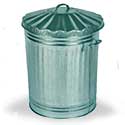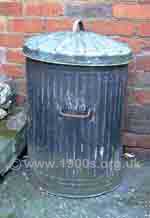Recycling in the past

Recycling was a way of life in Victorian times through to the early 20th Century, even though it wasn’t called that. This page explains why there was so little waste and describes the waste disposal of what little there was. It provides food for thought for us today with our emphasis on global warming and reducing greenhouse gases.
____
By the webmaster based on the memoirs of FEC (1906-2002), discussions with older people and additional research
My interest in old recycling methods began when I read my in mother's memoirs on waste disposal and refuse collection that people carried their dustbins out to the pavement for the dustman to collect.
This struck me as strange because full dustbins are heavy: During the 1940s and 1950s when I was growing up, dustmen came into side alleys and back gardens to collect dustbins, and householders did not have to carry them out. Even today, when householders do have to take their bins out to pavements for collection, thy are wheelie bins with wheels.
In the past there must have been much less rubbish. Why?
Why less refuse in the past: lessons for today

In the past, society actually had very little to dispose of. Here is why:
-
Most significantly, there were no bulky 'luxury' items to throw away: no televisions, no fridges, freezers, dishwashers, washing machines or tumble driers. Accordingly there was none of the bulky packaging that accompanies such items when they are delivered new.
-
Also significantly, there was no plastic. Food bought in shops was weighed out at the point of purchase and put into paper bags for women to carry home in their 'bag-for-life-style' wickerwork baskets or string bags. The paper bags were either burnt on the coal fired range or kitchen fire which was burning throughout the year apart from in heat waves, or put out in the back garden for a weekly bonfire, or put on the garden compost heap.
-
When things broke, normal practice was to mend them rather than throw them away. Travelling tinkers would repair leaking pots and pans and even staple together pieces of broken crockery. Knife grinders kept knives sharp, and other metal utensils were made to last as long as possible.
-
Newspapers, once read, were put to use. They were cut into squares and hung in the lavatory as toilet paper; they were used to light the coal fire, kitchen range or kitchen fire and the weekly garden bonfire; they were crumpled into wet shoes to draw out the moisture; they were used to wrap up left-over food scraps for disposal; and - if there were still any spare - they were sold as wrapping to fish and chip shops.
-
It was considered entirely acceptable for clothes that children had outgrown to be passed on to younger children rather than thrown away.
-
Clothes were darned or otherwise mended when they became thin or torn, and when they could be mended no longer, the best parts were cut out and used to make clothes for smaller children. This was even before the WW2 initiative of Make Do and Mend and was a way of life that was never questioned.
-
Whatever was left could normally be given or even sold to the rag and bone man who toured the streets regularly.
-
Food was fresh. Although tinned foods apparently existed, there is no mention in my mother's extensive memoirs of them ever being used in working class families. So there were no tins to dispose of.
How were ashes 'recycled'?
Ashes are worth a special mention because they were and still are heavy; and households in the past produced far more of them than we do today. This was because of heating water in coppers having the various fires mentioned above.
Disposal of the fire ashes in the past
contributed by Peter Johnson, childhood recollections
In my family in the 1930s and 40s, the coal ash and wood ash never went into the dustbin. We saved it and spread it on the garden. This was thought to improve the heavy London clay while also keeping the slugs at bay. We also took sacks of ash to our allotment to be dug into the soil, and this was common practice. Even soot from the chimney was saved for a year so that it lost its sulphur content and could be used for spreading around plants. People had done this for generations. Families who were not interested in gardening would knock on our door or come to the allotment to buy fruit and vegetables, or eggs from our hens in the back garden.
Of course there must have been a few families who wrapped their cold ashes in newspaper and disposed of them in the dustbin for the dustman to collect, but this was by no means the norm.
More ways that minimised waste
- Milk was delivered from churns into householder's own jugs. So there were no milk bottles or milk cartons to dispose of.
- Fruit and vegetable peelings and waste went onto garden compost bins and heaps.
- Other food scraps were given to chickens and rabbits which were eventually slaughtered for their meat, or for pets to eat.
- Whenever there was no life at all left in anything, it was saved for the rag and bone man. He didn't pay much but it was better than nothing. He travelled the streets to collect unwanted items, including worn-out clothes. Rag and bone men had their own markets for these things: Rags were used in paper-making and metals found their ways back to whatever smelting works dealt with the metal concerned.
- Personal waste products from nightly use of chamber pots and visits to outside lavatories that didn't flush were also put to use on compost heaps.
So what went into dustbins for refuse collection was minimal; and very little went into landfill. If a large item had to be disposed of, the first preference was the rag and bone man because he would pay us something for it. Dustmen would always take things away for tip of a few coppers. This was a source of income for them because they invariably knew how to dispose of most things profitably. In my own lifetime, when black plastic rubbish bags came in, there was industrial action by dustmen who considered that they were losing a source of income by not being able to pick over the refuse. I think they got a salary rise.
In summary, most waste for collection in the past must have been made up of only miscellaneous incidentals. No wonder householders could carry their dustbins out to the pavement for collection.
| sources | webmaster | contact |
Text and images are copyright
If you can add anything to this page or provide a photo, please contact me.



